How to build a learning culture in 10 steps
What does a great learning culture look like and why does it matter? Getting started with creating a learning culture within your organization.

Developing a meaningful learning culture helps facilitate continual employee improvement. Organisations can build a more effective workforce when employees have the opportunity and tools to improve their skills. However, a learning culture can be challenging to implement and harder to sustain. In this article, we will discuss:
- What is learning culture?
- Why is learning culture important?
- The challenges of building a learning culture
- How to create a learning culture in 10 steps
What is learning culture?
Developing a strong learning culture means a business actively seeks to provide training opportunities and install new knowledge or skills. As a result, the importance of learning becomes a core value which should flow through the entire organisation, influencing the way decisions are made and improving the way the organisation conducts its business operation.
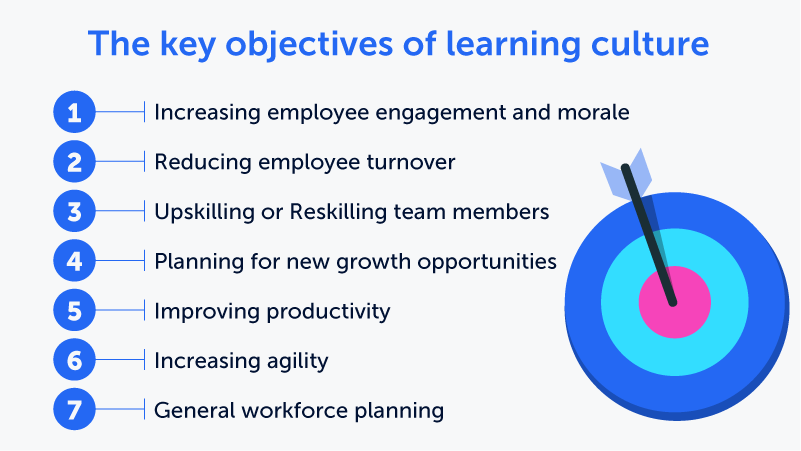
Typically, a learning culture helps facilitate key organisational objectives, which in turn support the improvement of overall performance. These could be:
- Increasing employee engagement and morale
- Reducing employee turnover
- Upskilling or reskilling team members
- Planning for new growth opportunities
- Improving productivity
- Increasing agility
- General workforce planning
Today, a culture for learning must consider the changing nature of the workplace.
Employees must constantly update their skills to match new technologies in a dynamic digital world. With this in mind, the goal of a strong learning culture should be to encourage, support, and provide tools for successful continuous learning. This ensures organisations can keep pace with new skillsets driving value in the business world and develop the best employees for a given role.
Almost every organisation utilises some form of L&D or employee training. Therefore, you could say every organisation has a learning culture.
However, only those that prioritise and actively develop a meaningful culture for learning, reap the full benefits.
Without proper attention, learning cultures in the workplace can quickly descend into a box-ticking exercise for compliance and not the valuable business tool it should be.
Characteristics of great learning culture
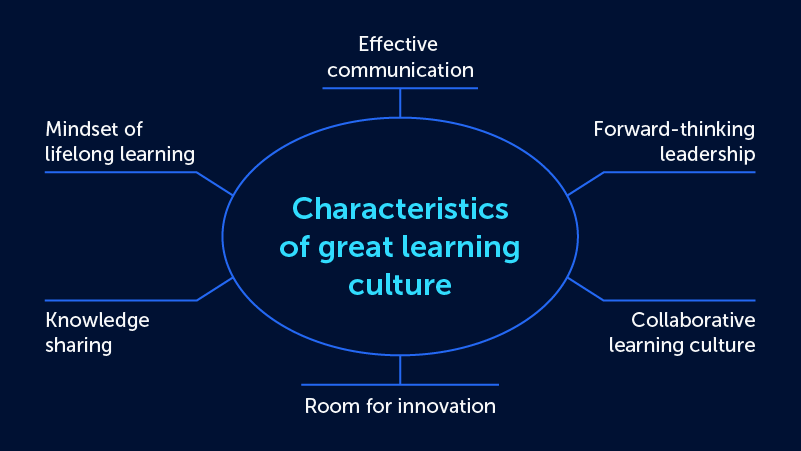
1. A mindset of lifelong learning
The best cultures ingrain a mindset of lifelong learning, where motivated employees strive for continuous self-development.
Whether it is in their professional or personal lives, lifelong learning means individuals proactively seek opportunities to better themselves, develop skills, and find new ways of thinking.
2. Effective communication
Communication is critical for successful learning cultures. Management and staff need to understand what is expected of each other as well as understand any emotions or nuances behind the communication to learn what the person’s intentions are. With this information, people can respond accordingly.
It is also important to remember the effectiveness of a communication style depends on the audience. Therefore, management should adapt their approach to achieve the desired outcome for different employees.
3. Forward-thinking leadership
Great learning cultures require forward-thinking leaders willing to invest time and money today for long-term success tomorrow.
These types of leaders consider the bigger picture beyond the next deadline or quarterly review and understand what could be possible with up-to-date employees taking advantage of cutting-edge skills.
They also set a great example, inspire those around them, and work hard to give employees opportunities to showcase their creativity and innovation.
4. Collaborative learning culture
Removing any boundaries or restrictions within the company so employees can share expertise and collaborate with one another goes a long way to generating a thriving learning culture.
When open collaboration is encouraged, it lifts the entire workforce, helping everyone to learn new skills and improve their work.
5. Room for innovation
Great learning cultures often result in innovative ways of working. To achieve this, organisations must empower employees, regardless of their role, to try new things, discuss ideas openly, and share new methods of improvement.
However, by their nature, new ideas can lead to unexpected results. When this happens, organisations must focus on the positives and not reprimand or embarrass staff trying to innovate.
6. Knowledge sharing
Sharing information across the organisation helps employees better understand their role and where it fits into the broader organisation.
Cross-skilling between teams and departments enables collaboration, with staff knowing what is needed from them and how they can improve to benefit others.
Examples could include managers and specialists taking the time to educate others or customer-facing employees sharing the feedback they hear to higher-ups in the company.

Build a learning culture: a practical workbook for your organization
Upgrade your organization’s learning culture with clear, actionable strategies to address the challenges.
Download workbookWhy is learning culture important?
While it is a broad concept that can take many forms, there is significant evidence that developing an effective learning culture benefits business.
Taking the time and setting aside the resources for employee development allows them to acquire new skills that enhance job performance.
When a learning culture flows through the entire workforce, it can impact all business areas.
Leaders at High Impact Learning Culture (HILC) organisations are 10x more likely to experience sustainable:
- Growth – thanks to more innovation and greater employee motivation
- Profitability – due to improved employee performance and external customer satisfaction
- Transformation – increased capacity to find solutions and quickly respond to new business conditions
- Productivity – this includes both productivity on the job and better talent management
These findings are backed up by research from Bersin by Deloitte. Their research demonstrates that high-performance learning organisations that build employee capabilities are:
- 92% more likely to innovate
- 46% more likely to be the first to market
- 17% more likely to be the market share leader
- 34% faster at responding to customer needs
- 26% better at delivering quality products
- 37% better employee productivity
- 58% more prepared to meet the demands of the future
Given the modern business landscape, adapting to future demands is particularly important. With digital transformation and a range of new technologies becoming widely available, organisations require constantly evolving skillsets to stay current.
Consequently, an influential learning culture is now more important than ever. A thriving culture for learning increases agility, giving businesses the ability to respond to the evolving talent requirements in the new digital economy.
A report by Deloitte found that 63% of workplace leaders struggle to find candidates with adequate skills, and 24% believe finding staff with the right skillsets is the biggest challenge they face in the next five years.
With a lack of supply to meet the demand, organisations must look internally and develop employee skillsets to ensure long-term success.
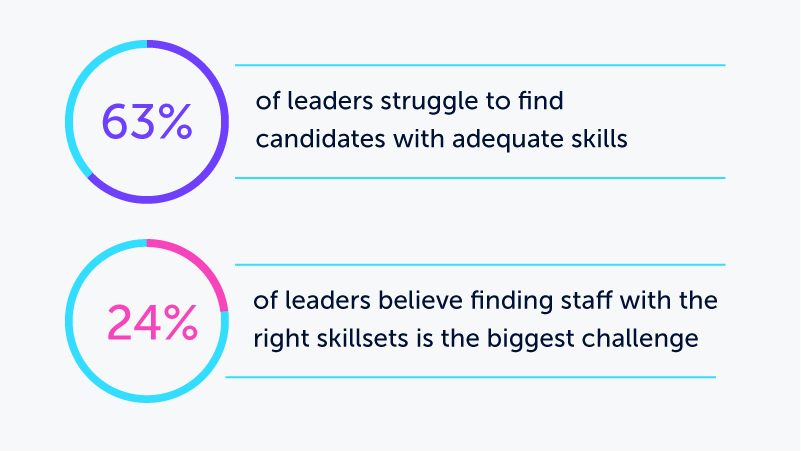
The World Economic Forum estimates companies plan to reskill and redeploy almost half of workers displaced by automation and new technologies by 2025. Transitioning staff and teaching new skills is easier when a culture of learning is already in place.

Source: Deloitte.
The challenges of building a learning culture
Given the value of workplace learning culture, why doesn’t every organisation have the processes and practices in place to emphasise it?
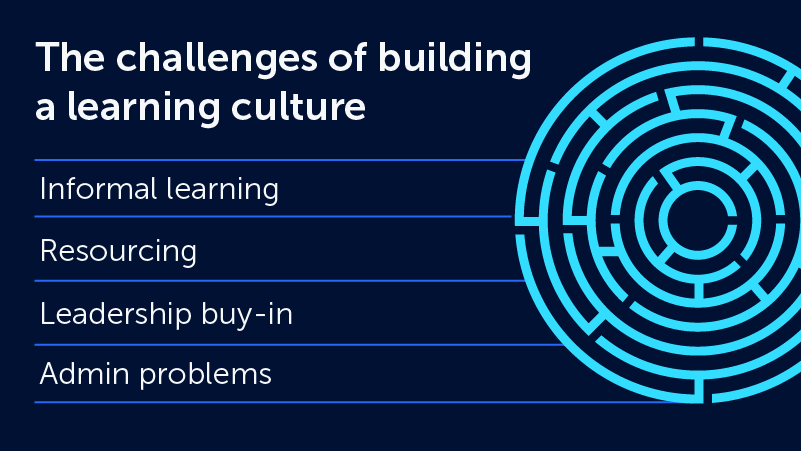
Unfortunately, building a learning culture is easier in theory than in practice. CIPD’s Professionalising Learning and Development report surveyed L&D professionals and found that almost all want to develop a positive culture of learning (98%). However, only 36% believe they have successfully created one.
This low success rate is a result of the significant challenges present when trying to build an impactful learning culture:
1. Informal learning
While every organisation needs formal training programmes, for a positive learning culture to develop, it must move beyond mandated sessions and become something employees want to do informally alongside their usual duties.

Example of informal learning: Valamis holds numerous employee events, providing opportunities to explore new activities. Here a group of Valamsians learns the art of figure painting
This requires organisations to provide the tools and resources for employees to take responsibility for their own learning. Then build incentive structures that motivate staff to prioritise personal development and an attitude of continual self-improvement.
Producing this mindset is challenging for organisations, and attempts can easily backfire. It is critical to find the right leadership style for each employee.
Becoming too involved and prescribing specific education/learning plans can take away autonomy and reduce flexibility, leading to worse learning outcomes. On the other hand, being too laid back and making few decisions can reduce employee urgency, failing to convey the importance of learning.
2. Allocating the proper resources
Many organisations want a positive learning culture and all the benefits it brings, but they fail to allocate the necessary resources to nurture it.
Organisational barriers that prevent a sustainable culture of learning include:
- Not giving staff dedicated time for learning
- Not providing resources to support learning
- Not successfully linking learning to future career development
3. Leadership buy-in
Organisations need leadership buy-in and a willingness to invest in learning to allocate sufficient resources. Yet, CIPD’s Professionalising Learning and Development report found that 76% of L&D professionals felt learning was not a management priority, and 64% said learning was seen as a cost centre, not an investment.
Without a willing leadership team, developing a learning culture is tough. L&D staff must demonstrate the value of emphasising employee development to earn buy-in starting at the organisation’s top.
Beyond leadership, managers directly overseeing staff must buy in and be willing to allow employees time away from their duties to focus on learning.
4. Administrative problems
Administrative problems can often ruin attempts at building a wide-reaching learning culture within a company. Organisational processes must be in place to allow the seamless access and sharing of information and educational content.
It is also vital to promote social and/or collaborative learning. When employees share the learning experience with others, it is more likely to become embedded within the organisation.
Previous research has shown the difficulties of building a learning culture within an organisation of dispersed individuals.

Build a learning culture: a practical workbook for your organization
Upgrade your organization’s learning culture with clear, actionable strategies to address the challenges.
Download workbookHow to build a learning culture in 10 steps
Adapting and adopting a workplace culture to focus on learning and professional development does not happen overnight. However, there are meaningful steps organisations can take to help promote and encourage learning amongst employees.
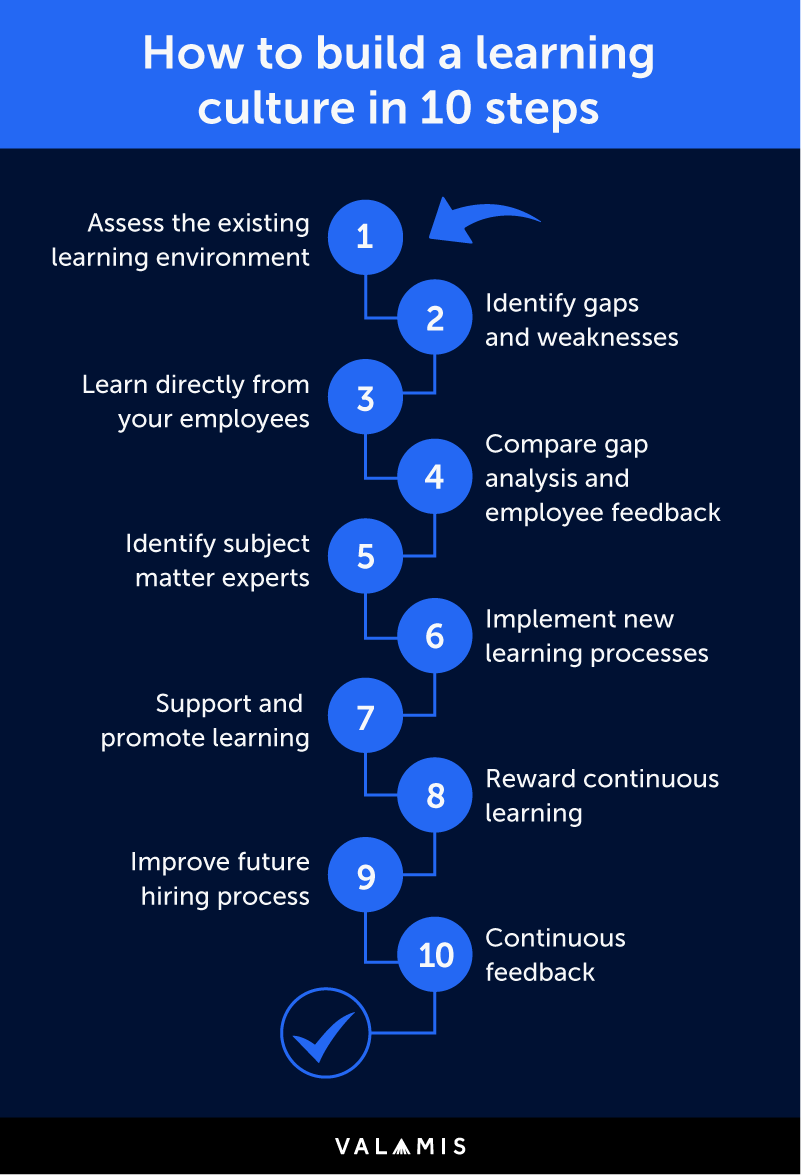
1. Assess the existing learning environment
The first step is to understand the current learning environment. You need to know your starting point to decide what to build.
While this includes formal training programs, they are only part of the wider learning environment. You need to understand how employees develop skills and the sources of education at your organisation, including knowledge transfer amongst staff, coaching, self-study, on-the-job training, social learning, etc.
Assessing the impact of more informal learning processes can be difficult, but it helps to gather data from staff on their existing skills and how they were developed.
Practical tasks to complete when evaluating the existing learning environment include:
- Gathering organisational data related to current learning practices
- The uptake of learning opportunities among staff
- Performing employee focus groups and interviews
2. Identify gaps and weaknesses
With the knowledge of your existing learning environment, you can discover the gaps and potential weaknesses that need consideration.
This could be specific knowledge or skills that are lacking in your workforce, a lack of access to learning material, or even departments/teams where there seem to be more significant barriers to learning.
Related article: Skills gap
3. Learn directly from your employees
The best learning cultures have employees at the core; the goal should be to facilitate a continuously improving workforce. With that in mind, obtaining first-hand information from team members on:
- What they want to learn – with specific content in mind, you can start to build tailored employee development plans.
- How they want to learn – everyone learns differently, and workplace cultures should support multiple learning environments and styles.
Leadership teams could capture this information through face-to-face interviews, surveys, anonymous feedback, or a dedicated learning management system (LMS).
4. Compare gap analysis and employee feedback
By comparing the outcomes of steps 2 & 3, you can select areas of focus and identify learning strategies to implement.
You should plan what you need from your new learning culture, what employees want, and how best to promote new practices.
Broad formal training programmes can establish a baseline of skills and information the organisation expects from the entire workforce. Then more specialised content can help specific departments. Finally, informal individual learning can target improving skillsets for each role.
Before working on the content itself, organisations must first decide the mechanisms to implement for each scale of learning. From large training programmes (delivered in a lecture style) to smaller break-out groups to on-the-job training and setting aside time and resources for self-study.
5. Identify subject matter experts
A common barrier when building a new learning culture is ensuring you have the teaching material to create successful outcomes. Therefore, organisations need to identify subject matter experts (both internally and externally) to work with L&D staff and develop relevant educational content.
Whether it is hiring an outside agency to deliver learning experiences or asking experienced employees to impart expertise they’ve developed over the years.
Knowledge sharing is a fundamental part of building a learning culture. Internal experts with the perfect mix of institutional knowledge and skills can be the best teachers for the next generation of employees.
Plus, it can help set the tone of the new culture, where staff are expected to share the information that makes the company operate successfully.
6. Implementing new learning processes
When implementing new processes, practices, and structures that underpin a comprehensive learning culture, there is a lot to consider.
The strategies you choose will depend on the specifics of your organisation and should be based on the outcome of the previous steps.
However, for a learning culture to become successfully integrated into the workplace, it must become a part of the team’s day-to-day life. Research shows integrating learning into the flow of work is 35% more prevalent in high-performing learning organisations compared to an average one.
You need to make it as easy as possible for employees to make habit-forming learning processes part of their role. Every staff member may do this differently, but management can work to remove any potential barriers holding them back.
This could be making educational content easily accessible, building time for learning into employee schedules, or implementing a dedicated learning solution to track each employee’s progress.
7. Support and promote learning
Employees need to be made aware of any new learning opportunities and helped in any way management can to undertake training on their own initiative. This means promoting and supporting all new learning processes and showing the staff the potential rewards of self-improvement.

Example of promoting learning: A group of Valamasians learns to cook authentic Georgian cuisine at the Martat cookery school during Development Days in Joensuu, Finland (company head office)
Effective approaches include:
- Leading by example – Leadership behaviour strongly influences how staff will react to a new emphasis on learning. Organisations can reinforce a learning culture with direct engagement from management and active continuous learning participation.
- Make it social – For many employees, learning in a group is preferable to individual study. Bringing people together and injecting some fun can also encourage more people to partake.
- Accessibility – Make educational material instantly accessible on demand wherever and whenever staff want to learn. Build an online library of resources relevant to the learning outcomes you hope to achieve, then direct team members to it.
- Adapt – You’re unlikely to build a perfect learning culture straight away. It is much more likely mistakes will occur along the way. Therefore, organisations should be flexible and willing to adapt learning practices to better match their workforce.
8. Rewarding continuous learning
Perhaps the best way to promote learning in the workplace is to reward staff who help support the new culture and exhibit the right attitudes and behaviours. Recognition and positive reinforcement go a long way to building staff buy-in.
This could range from smaller soft rewards like public acknowledgments (for staff learning a new skill) to larger rewards such as financial incentives and internal promotions.
By linking learning and employee development to internal mobility and working your way up at an organisation, staff will see the benefits of the learning culture for themselves.
9. Future hiring practices
Strong learning cultures require compatible employees with a mix of curiosity, openness to share knowledge, humility, and willingness to accept they don’t know it all. While it may be difficult to force a learning culture on existing staff without these characteristics, fostering your new culture can become a critical factor when hiring new employees.
Discuss learning commitments during employee interviews and assess what a new hire could bring to your organisation’s culture.
Showcasing a commitment to employee development and the opportunities they present can also improve a business’s employer value proposition.
10. Continuous feedback
Continuous feedback can maintain employee engagement and demonstrate the importance placed on learning. It keeps the idea of education front and centre and reminds people to continue developing their skills.
Regularly check in with staff and let them know what they are doing well and where they can improve. If they recently picked up a new skill or developed a new idea that can be traced back to the learning culture, make sure to reiterate the success of the processes.
When it comes to learning, highlighting existing knowledge gaps is a good way to trigger curiosity. People are often unaware of their own limitations and what they don’t know.
When handled correctly and presented in a constructive manner, it is possible to drive learning outcomes by highlighting an employee’s lack of knowledge. This could be asking them to consider their work within the wider organisation or a specific challenge to learn a new capability.
It is also critical to ask for feedback from your employees. For example, what was the value of particular educational material? Are they in the best environment for their learning style? Are there barriers currently preventing them from successfully learning in the workplace?
Generating value from your learning culture
Sustaining a learning culture requires continual investment. To generate value from your learning culture, you need to provide staff with the time and resources they need and demonstrate its worth.
However, the right learning culture can improve everything it touches. From curious staff always hunting for innovation to modern operations taking advantage of the most up-to-date software, the whole organisation benefits when everyone prioritises learning and improvement.

Build a learning culture: a practical workbook for your organization
Upgrade your organization’s learning culture with clear, actionable strategies to address the challenges.
Download workbook



